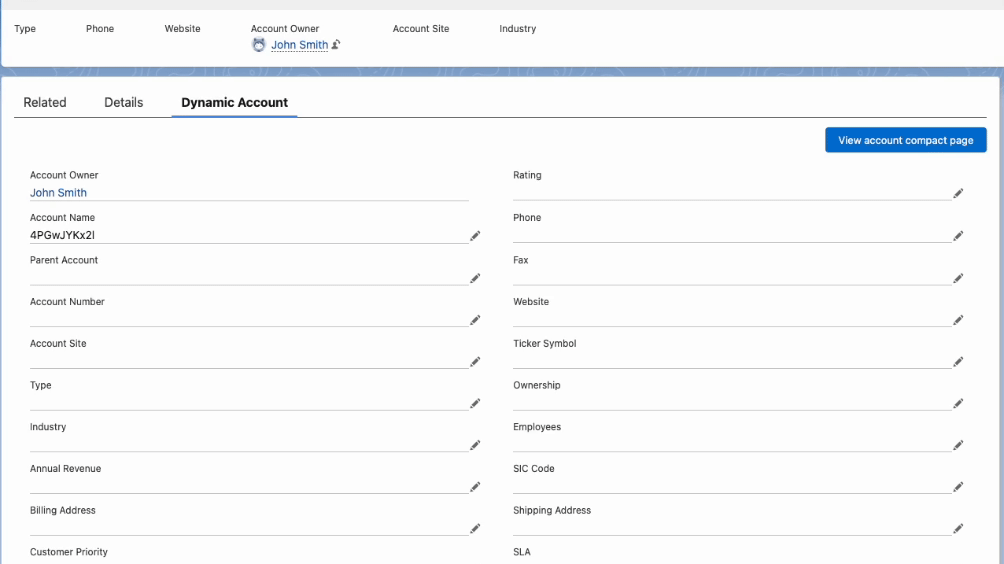Dynamic components in lightning web components (lwc)
How to use dynamic components
To implement dynamic components in lightning web components, utilize the new lwc:component tag with the lwc:is attribute.
lwc:component is a placeholder tag and will be replaced with the actual component at run time
lwc:is directive a required attribute and it signals the compiler that component is unknown at compile time
<div class="container">
<lwc:component lwc:is={dynamicInstance}>
</lwc:component>
</div>*dynamicInstance is the dynamic component that is resolved at run time
import { LightningElement } from "lwc";
export default class extends LightningElement {
dynamicInstance;
connectedCallback() {
import("c/accountCompactDetails")
.then(({ default: ctor }) => (this.dynamicInstance = ctor))
.catch((err) =>
}
<?xml version="1.0" encoding="UTF-8"?>
<LightningComponentBundle xmlns="http://soap.sforce.com/2006/04/metadata">
<apiVersion>59.0</apiVersion>
<capabilities>
<capability>lightning__dynamicComponent</capability>
</capabilities>
</LightningComponentBundle>
To use dynamic component, the component must include 'lightning__dynamicComponent' capability in the component configuration file and sets the api version to 59 or higher
Runtime Behavior
When a lightning component is rendered, the dynamic component is mounted in the DOM and when lwc:is changed, the component will be unmounted. The new component will be mounted instead.
To select a dynamic component, use lwc:ref directive or any attribute like class name attached to the component.
- Use connected callback in the dynamic component
- Or use renderedCallback on the parent component
The child elements can also be added in a dynamic component. The dynamic component will be rendered first and then the child components.
An example below:
<div class="container">
<lwc:component lwc:is={dynamicInstance}>
<div>
<p> End of dynamic component</p>
</div>
</lwc:component>
</div>Things to consider
As the dynamic component is unknown at compile time, the framework does not prefetch the dynamic modules. This may cause a slight delay at run time.
The dynamic nature of the component causes the component hierarchy to be re-rendered which may lead to performance issues.
Complete code example
Here we have a dynamic component that will show the account full / compact view on click of a button. The onclick action on the button will rerender the component and the respective view mode will display the details.
<template>
<div class="slds-clearfix">
<div class="slds-float_right">
<lightning-button variant="brand" label={btnLabel} title="View details" onclick={handleViewDetails} class="slds-m-left_x-small"></lightning-button>
</div>
</div>
<div class="slds-p-around_medium">
<lwc:component lwc:is={dynamicInstance} record-id={recordId}>
</lwc:component>
</div>
</template>import { LightningElement,api } from 'lwc';
export default class AccountInfo extends LightningElement {
@api recordId;
dynamicInstance;
showDetails = false;
get btnLabel(){
return this.showDetails?'View account compact page':'View account full page';
}
connectedCallback(){
import("c/accountCompactDetails")
.then(({ default: ctor }) => (this.dynamicInstance = ctor))
.catch((err) =>
}
handleViewDetails(){
if(this.showDetails){
import("c/accountCompactDetails")
.then(({ default: ctor }) => (this.dynamicInstance = ctor))
.catch((err) =>
this.showDetails = false;
}
else{
import("c/accountDetails")
.then(({ default: ctor }) => (this.dynamicInstance = ctor))
.catch((err) =>
this.showDetails = true;
}
}
}<?xml version="1.0" encoding="UTF-8"?>
<LightningComponentBundle xmlns="http://soap.sforce.com/2006/04/metadata">
<apiVersion>59.0</apiVersion>
<isExposed>true</isExposed>
<targets>
<target>lightning__RecordPage</target>
</targets>
<capabilities>
<capability>lightning__dynamicComponent</capability>
</capabilities>
</LightningComponentBundle>Demo

What is Decodeforce?
Decodeforce is a dedicated platform aimed at helping Salesforce developers improve their Apex coding skills by solving real-world programming challenges
Solve a number of practice scenarios in DML, SOQL, trigger and many more on Decodeforce.
To know more click the Get started button below